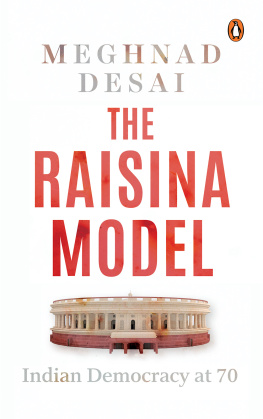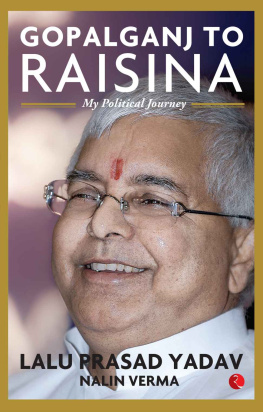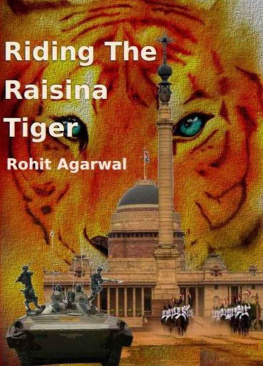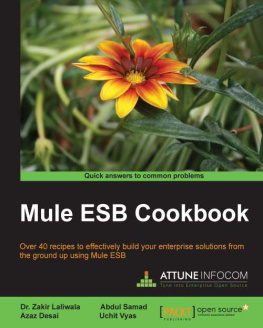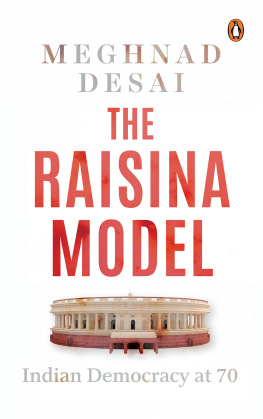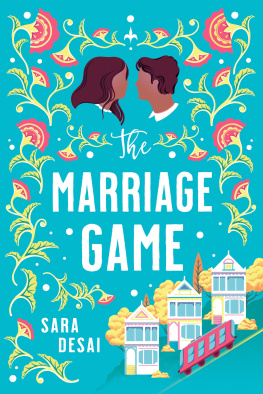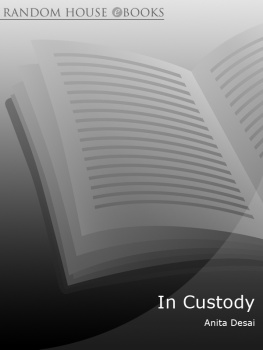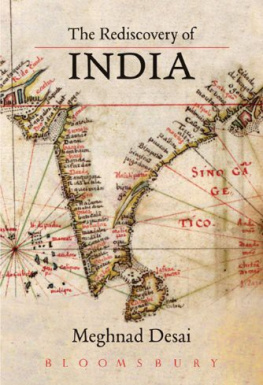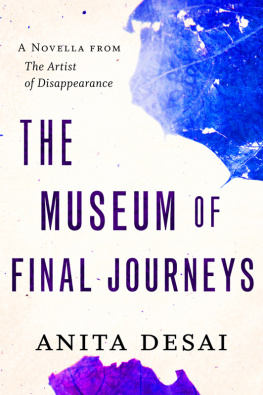Meghnad Desai - The Raisina Model
Here you can read online Meghnad Desai - The Raisina Model full text of the book (entire story) in english for free. Download pdf and epub, get meaning, cover and reviews about this ebook. year: 2017, publisher: Penguin Random House India Private Limited, genre: Politics. Description of the work, (preface) as well as reviews are available. Best literature library LitArk.com created for fans of good reading and offers a wide selection of genres:
Romance novel
Science fiction
Adventure
Detective
Science
History
Home and family
Prose
Art
Politics
Computer
Non-fiction
Religion
Business
Children
Humor
Choose a favorite category and find really read worthwhile books. Enjoy immersion in the world of imagination, feel the emotions of the characters or learn something new for yourself, make an fascinating discovery.
- Book:The Raisina Model
- Author:
- Publisher:Penguin Random House India Private Limited
- Genre:
- Year:2017
- Rating:3 / 5
- Favourites:Add to favourites
- Your mark:
- 60
- 1
- 2
- 3
- 4
- 5
The Raisina Model: summary, description and annotation
We offer to read an annotation, description, summary or preface (depends on what the author of the book "The Raisina Model" wrote himself). If you haven't found the necessary information about the book — write in the comments, we will try to find it.
The Raisina Model — read online for free the complete book (whole text) full work
Below is the text of the book, divided by pages. System saving the place of the last page read, allows you to conveniently read the book "The Raisina Model" online for free, without having to search again every time where you left off. Put a bookmark, and you can go to the page where you finished reading at any time.
Font size:
Interval:
Bookmark:




PENGUIN BOOKS

PENGUIN BOOKS
NON-FICTION
Marxian Economic Theory
Applied Econometrics
Marxian Economics
Testing Monetarism
Macroeconomics and Monetary Theory: The Selected Essays of Meghnad Desai, vol. 1
Poverty, Famine and Economic Development: The Selected Essays of Meghnad Desai, vol. 2
Marxs Revenge: The Resurgence of Capitalism and the Death of Statist Socialism
Development and Nationhood: Essays in the Political Economy of South Asia
Nehrus Hero: Dilip Kumar in the Life of India
Divided by Democracy: Why Is India a Democracy and Pakistan Is Not a Democracy (with A. Ahsan)
Rethinking Islamism
The Route of All Evil: The Political Economy of Ezra Pound
The Rediscovery of India
Who Wrote the Bhagavad Gita: A Secular Inquiry into a Sacred Text
Pakeeza: Ode to a Bygone Era
Hubris: Why Economists Failed to Predict the Crisis and How to Avoid the Next One
Politicshock: Trump, Modi, Brexit and the Prospect for Liberal Democracy
FICTION
Dead on Time
EDITED WORKS
The Cambridge Economic History of India 17571970 (with D. Kumar)
Agrarian Power and Agricultural Productivity in South Asia (with S. Rudolph and A. Rudra)
Lectures on Advanced Econometrics by Denis Sargan
Introduction: Lenins Economic Writings
Global Governance: Ethics and Economics of the World Order (with P. Redfern)
LSE on Equality
Methodology, Microeconomics and Keynes: Essays in Honour of Victoria Chick, vol. 2 (with P. Arestis and S. Dow)
Money, Microeconomics and Keynes: Essays in Honour of Victoria Chick, vol. 1 (with P. Arestis and S. Dow)
Financial Crises and Global Governance (with Y. Said)
For three young Indians
who will have to take the story further
Mallika, Priyanka and Gaurav
If you stand in the front balcony of Rashtrapati Bhavan, just outside its library, you have a stunning view of Raisina Hill. The architecture of Imperial Delhi sprawls below you down the Rajpath. What you see is the breathtaking arrogance of the imperial imagination. Lutyens and Baker knew what it meant to construct New Delhi as the seat for the largest colony of the British Empire. It was meant to fill the ruler with pride and the ruled with awe, to signal the permanence of British domination of the Indian subcontinent.
Alas, history is a cruel mistress. While the British built the structures which fill Raisina Hill, they did not stay to enjoy them for long. The new rulers were not intimidated by the imperial grandeur. They moved right in and took over as if nothing much had changed. Despite the chaos of Partition, it was the smoothest transition from one Raj to anotherBritish Raj to Congress Raj.
Seventy years down the line, how well have Indians done since the transition? What explains the survival of India as a single entity about which Winston Churchill had expressed such major doubts? He had said India was no more a reality than the Equator. Indians had their answer; the narrative which helped them fight the foreign rulers. But could anything unite the Indians when the common enemythe foreign rulerwas gone?
There are other questions to ask. Could India have done better economically, removed poverty faster, equipped its citizens with literacy, numeracy and skills sooner, improved the position of women and tribals and Dalits and Muslims and OBCs (Other Backward Classes)? Why do we still have trouble in Kashmir? Why are we still fighting the Naxalites? Why do the people of the North-east have a sense that many people in the rest of India do not accept them as their own?
This book celebrates seventy years of Indian independence but it is not a celebratory book. It asks questions, seeks answers and raises doubts even as it notes the achievements. My aim is to stimulate responses and set off debates.
What are my credentials for writing this book? I left India in August 1961, a few weeks after my twenty-first birthday and a few days before Indias fifteenth Independence Day, to study abroad and have since settled in the UK. But I have maintained a passionate interest in the fortunes of India and Indians. Distance has the advantage of lending clarity to ones view and enables one to cut out the noise and notice the signals. Of course, when I say something which is an unpalatable truth (often on TV programmes where I feature), I am reminded that I am really a foreigner. That reassures me that I have hit the spot I wanted to.
I have been writing about India off and on since 1967, when my very first article which was my take on how India encountered the West since the arrival of the Portuguese in 1498. I write regularly for the Indian Express and the Financial Express and did so for the Business Standard between 1996 and 2001.
This is my most recent attempt to understand India. I hope readers engage with it. India being what it is, and knowing my own predilections, I shall no doubt revisit the subject again and again.
India has been an independent nation state for seventy years. As a civilization it is one of the oldest in the world. The novelty is the young nation state, not the old civilization.
It is best to contrast India with the European Union (EU) even though one is a collection of nations while the other is a single nation state.
The EU is fifty years old, a bit younger than India. As a civilization, Europe (which is larger than the EU) is ancient too, yet younger than India. The EU is 4,475,757 square kilometres in territorial size and has a population of 510 million in its twenty-eight constituent nations (soon to be twenty-seven when the UK withdraws) and twenty-four languages. India has 3,287,263 square kilometres of territory and a population of 1326 million. It has twenty-nine states and twenty-two official languagesthough in reality many more and thousands of dialects.
The Indian Union is a unified, single nation state. The EU is a union of independent countries. The motto of the EU is In Veritate Concordia which translates as united in diversity. This is not unlike Indias oft-repeated mantra unity in diversity.
The EU is a continuing experiment. Though the UK is withdrawing, other European countries may join it. Norway and Switzerland are not in the EU but associated with it. The EU wishes to integrate more closely.
At its birth, Partition broke up what was India before 1947. It was a larger union, but only in retrospect can we see that India since its pre-Independence days has travelled in a direction opposite to that of the EU. In the latter case, disparate and previously hostile nations came together in 1957 to form a union. India split at first into two units, India and Pakistan. There have been no further ructions within India unlike in its neighbour Pakistan which split into two. Why has this been so? The real challenge is to understand what forces have kept India united. It was not inevitable. It is the greatest achievement of independent India that it is, even after seventy years, a single nation state. It is an achievement easily taken for granted. Yet it has been hard work. India is also, among postcolonial countries, the most successful parliamentary democracy. It is a miracle of sorts.
Font size:
Interval:
Bookmark:
Similar books «The Raisina Model»
Look at similar books to The Raisina Model. We have selected literature similar in name and meaning in the hope of providing readers with more options to find new, interesting, not yet read works.
Discussion, reviews of the book The Raisina Model and just readers' own opinions. Leave your comments, write what you think about the work, its meaning or the main characters. Specify what exactly you liked and what you didn't like, and why you think so.

